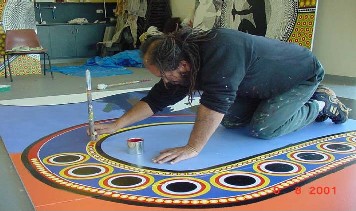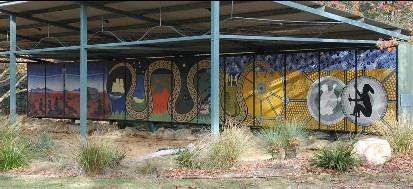Upper Hunter Case Study : Reading 105
The Reconciliation Mural
Reconciliation Mural
The graphic design of all the banners on the tops of the web pages on this web site has been based on the Reconciliation Mural by George Anderson and assisting artists and George Anderson's original design for the mural.
The original design is on display at the Muswellbrook Shire Council Administration Centre.
The Muswellbrook Reconciliation Mural is located in the south eastern corner of Simpson Park, corner of Bridge (New England Highway) and Market Streets, Muswellbrook.
Title: Reconciliation Mural
Date: 2001/4
Designed by: George Anderson
Lead Artist: George Anderson
Artists Assisting: Les Elvin, Brad Franks and John Neville
Collection: Muswellbrook Shire Art Collection

The Mural
The Muswellbrook Shire Council Reconciliation Committee first proposed a mural depicting the concept of black and white reconciliation in 1999. Over the following twelve months the Committee secured the services of well known local Aboriginal artist George Anderson to design the work and began the task of seeking funding for the project. Initial assistance was forthcoming from the Upper Hunter Community Arts Development Officer and sponsorship was eventually sourced from a range of private individuals, commercial businesses, community and church groups and governments, giving the project truly broad based backing.

George Anderson’s design went on display to the public in July 2000 at the Muswellbrook Shire Council Administration Centre. To create a unique and yet inclusive picture George spent many hours with aboriginal elders from the Upper Hunter gathering stories and feelings about the local history of Aboriginal and European contact in the valley. The design was also subject to final approval by the Reconciliation Committee. George’s ability to combine strait forward story telling with symbols drawn from aboriginal iconography and combine these in a bold and pleasing design meant that the project received support from across the community.
By early 2001 work had commenced on the painting of the mural utilising
the Community Room at the Muswellbrook Regional Arts Centre as the
studio. This allowed the public to watch the mural take shape on
a daily basis
and further enhance the sense of local ‘ownership’. In recognition
of the size of the undertaking (the finished mural would be 2.5
metres high by 17 metres long painted across 14 panels of waterproof
fibro-cement)
George was joined by artist John Neville to assist with the project.
In August 2001 the Muswellbrook Shire Council Document for Reconciliation
was signed by representatives of the local Aboriginal community
and the council. As part of the signing ceremony community members,
elders,
and
dignitaries laid their painted hands upon sections of the mural
as a symbol of their support for the reconciliation process. This
fulfilled
one of
George Anderson’s original visions for the mural.
With the securing of further funding the Mural Project entered its second stage during 2003. Plans were commissioned for the construction of the building to house the mural in Simpson Park and George put together a team to complete the painting. Joined by Les Elvin and Brad Franks, George further developed the themes of the original design enhancing the story telling without compromising the artistic integrity of the work. The final design of the building was inspired by the natural sandstone shelters in which the local Aboriginal people have traditionally painted images and symbols here in the Upper Hunter.
The Mural was unveiled to the public on 19th March 2004 at a ceremony which also launched the local Aboriginal history book ‘Wannin Thanbarran’. What people saw was the story of black and white contact in Australia given an Upper Hunter context. From the left the panels depict pre-contact: a family group at home in the landscape, then we see the HMS Endeavour charting the coastline as the Rainbow Serpent is stirred to anger, sailors row to shore observed by the locals, a massacre takes place as a watcher witnesses from the trees, the lands are cleared for farming, the Aboriginal population is excluded to the fringes of the new towns, power and mining come to the Hunter and the land is further degraded, but then hope arises in the form of the Reconciliation movement represented by the merging of black and white in the final panels. Reconciliation is shown as an ongoing process which has just begun, a signpost to a future in which black and white are as one sharing Australia and it’s unique heritage.
The Reconciliation Mural Project was funded by Muswellbrook Shire Council, Department of Infrastructure, Planning and Natural Resources, Coal and Allied Aboriginal Development Consultative Committee, NSW Ministry for the Arts, Rosemount Estate, Coolmore Australia, Muswellbrook Coal Company Limited, Mt. Arthur Coal, Macquarie Generation, Anglican Parish of Muswellbrook, Arts Upper Hunter Incorporated and George Tasker.


